Quantifying Estuarine Hydrometeorological Coastal Hazards Using a Combined Field Observation and Modeling Approach
Abstract
:1. Introduction
- Wind speeds and TWL residuals created by cyclonic and non-cyclonic meteorological events cause potentially hazardous inundation and erosion events;
- Temporally grouped or clustered meteorological events cause increased inundation and erosion hazards compared to clustered events that occur individually.
2. Materials and Methods
2.1. Study Site Characteristics
2.2. Remote-Sensing Surveys
2.3. Hydroacoustic Time Series
2.4. Publically Available Data
2.5. Analyses
2.5.1. Spatial
2.5.2. Coastal Risk
- Storm: Hs > 0.84 m and U10 > 13.6 m/s and Patm < 1015 mb;
- Wind: Hs > 0.84 m and U10 > 13.6 m/s and Patm > 1015 mb;
- Sunny: Hs > 0.84 m and U10 < 13.6 m/s.
2.5.3. Clustered Morphological Events
3. Results
3.1. Morphological Change
3.2. Hazard Identification
Exceedance Thresholds and Event Identification
3.3. Risk Assessment
3.3.1. Return Periods
3.3.2. JPA
3.3.3. Event Clusters
4. Discussion
4.1. Extreme Events Types and Thresholds
4.2. Clustered Events
4.3. Limitations and Future Research
5. Conclusions
Supplementary Materials
Author Contributions
Funding
Data Availability Statement
Acknowledgments
Conflicts of Interest
Appendix A
| Dataset Type | Source | Period | Sampling Frequency | Vertical Datum | Analyses |
|---|---|---|---|---|---|
| Water level | NOAA CO-OPs: Station 8557380 | 2015–2019 | Hourly, 6 min | MLLW | TWL and residuals, storm surge, statistical thresholds, exceedance probabilities |
| NOAA NDBC: Station LWSD1 * | 2015–2019 | Hourly, 6 min | MLLW | ||
| DWM | NOAA WPC | 2003–2019 | Daily | --- | Cyclone identification, morphological event ground-truthing |
| Met Events | Daniel Leathers [38] | 1851–2019 | --- | --- | Cyclone identification, historical cluster frequency |
| Wind Speed, Wind Direction, Barometric Pressure | NOAA CO-Ops: Station 8557380 | 2015–2019 | Hourly, 6 min | 10 m above site elevation | Event type identification and statistics, JPA, sediment critical threshold of motion |
| NOAA NDBC: Station LWSD1 1 | 2015–2019 | Hourly, 6 min | 3.69 m above MSL | ||
| Hs | TRDI ADCP | 2016–2019 | 30 min average | --- | Corrected WW3 data, statistical thresholds, exceedance probabilities, JPA, Run-up |
| WW3 | 2015–2019 | 3 h | --- | Event type identification and statistics | |
| Current Velocity, Backscatter | TRDI ADCP | 2016–2019 | 30 min average | --- | Cluster interval, event thresholds, sediment critical threshold of motion |
| Nortek Aquadopp HR Profiler | 2016–2019 | 30 min average | --- | ||
| Topobathy-metry | DJI Phantom 3 Pro | 2012–2018 | Pre- & post-storm | MSL or MHHW | Normalized volumetric change, Dune toe elevation, Vertical threshold determination, exceedance probability |
| senseFly RTK eBee | |||||
| Topcon GR-5 RTK GPS | Biannually | ||||
| DNREC profiles | |||||
| Exceedance Probabilities | ERDC 2 | --- | --- | MHHW | Event exceedance probability |
| NOAA 3 | 1920–2019 | MLLW |
Appendix B
| Event | Type | TWLMMHW [m] | Return Period [Years] |
|---|---|---|---|
| December 1960 | XC | 0.35 | <1 |
| March 1962 | XC | 1.03 | 8.6 |
| November 1968 | XC | 0.84 | 3.1 |
| January 1987 | XC | 0.43 | <1 |
| October 1991 | XC | 0.37 | <1 |
| February 1998 | XC | 0.79 | 1 |
| Sandy; October 2012 | TC | 1.23 | 42.8 |
| Joaquin; October 2015 | TC | 0.86 | 3.8 |
| Jonas; February 2016 | XC | 1.38 | 74.3 |
| Hermine; September 2016 | TC | 0.52 | <1 |
| Jose; September 2017 | TC | 0.34 | <1 |
| Grayson; January 2018 | XC | 0.50 | <1 |
| Inga; January 2018 | XC | 0.21 | <1 |
| Riley; March 2018 | XC | 0.65 | <1 |
| Quinn; March 2018 | XC | 0.60 | <1 |
| Skylar; March 2018 | XC | 0.33 | <1 |
| Toby; March 2018 | XC | 0.61 | <1 |
| June 2019 | XC | 0.46 | <1 |
| Dorian; September 2019 | TC | 0.69 | <1 |

| Interval [Days] | DWM | U10 | Storm | Sunny | Wind | TWLres | All |
|---|---|---|---|---|---|---|---|
| 2 | --- | 22 | 0 | 15 | 0 | 16 | 31 |
| 3 | 45 | 37 | 0 | 23 | 0 | 18 | 48 |
| 4 | 59 | 53 | 2 | 35 | 1 | 33 | 77 |
| 5 | 59 | 63 | 3 | 46 | 2 | 49 | 94 |
| 6 | 59 | 72 | 6 | 54 | 2 | 54 | 103 |
| 7 | 59 | 77 | 7 | 60 | 2 | 60 | 107 |
| 9 | 60 | 88 | 8 | 68 | 2 | 72 | 125 |
| 14 | 75 | 111 | 15 | 77 | 4 | 93 | 151 |
References
- Callahan, J.A.; Leathers, D.J.; Callahan, C.L. Skew Surge and Storm Tides of Tropical Cyclones in the Delaware and Chesapeake Bays for 1980–2019. Front. Clim. 2021, 3, 610062. [Google Scholar] [CrossRef]
- Jackson, N.L. Wind and waves: Influence of local and non-local waves on mesoscale beach behavior in estuarine environments. Ann. Assoc. Am. Geogr. 1995, 85, 21–37. [Google Scholar]
- Jackson, N.L.; Nordstrom, K.F.; Eliot, I.; Masselink, G. ‘Low energy’ sandy beaches in marine and estuarine environments: A review. Geomorphology 2002, 48, 147–162. [Google Scholar] [CrossRef]
- Lee, S.C.; Mehta, A.J. Problems in characterizing dynamics of mud shore profiles. J. Hydraul. Eng. 1997, 123, 351–361. [Google Scholar] [CrossRef]
- Zhang, K.; Douglas, B.C.; Leatherman, S.P. Beach erosion potential for severe nor’easters. J. Coast. Res. 2001, 309–321. [Google Scholar]
- Jiménez, J.; Armaroli, C.; Bosom, E. Preparing for the impact of coastal storms: A coastal manager-oriented approach. In Coastal Storms: Processes and Impacts; Paolo, C., Giovanni, C., Eds.; John Wiley & Sons Ltd.: West Sussex, UK, 2017; pp. 217–239. [Google Scholar]
- Jiménez, J.; Gracia, V.; Valdermoro, H.I.; Mendoza, E.T.; Sànchez-Arcilla, A. Managing erosion-induced problems in NW Mediterranean urban beaches. Ocean Coast. Manag. 2011, 54, 907–918. [Google Scholar] [CrossRef]
- Bertin, X.; Olabarrieta, M.; McCall, R. Hydrodynamics in Storm Conditions. In Coastal Storms: Processes and Impacts; Paolo, C., Giovanni, C., Eds.; John Wiley & Sons Ltd.: West Sussex, UK, 2017; pp. 24–43. [Google Scholar]
- Dohner, S.M.; Pilegard, T.C.; Trembanis, A.C. Coupling Traditional and Emergent Technologies for Improved Coastal Zone Mapping. Estuaries Coasts 2020, 11, 1–23. [Google Scholar] [CrossRef]
- Dissanayake, P.; Brown, J.; Wisse, P.; Karunarathna, H. Effects of storm clustering on beach/dune evolution. Mar. Geol. 2015, 370, 63–75. [Google Scholar] [CrossRef]
- Loureiro, C.; Ferreira, Ó.; Andrew, J.; Cooper, G. Extreme erosion on high-energy embayed beaches: Influence of megarips and storm grouping. Geomorphology 2012, 139–140, 155–171. [Google Scholar] [CrossRef]
- Luceño, A.; Menéndez, M.; Méndez, F.J. The effect of temporal dependence on the estimation of the frequency of extreme ocean climate events. Proc. R. Soc. A Math. Phys. Eng. Sci. 2006, 462, 1683–1697. [Google Scholar] [CrossRef]
- Lee, G.H.; Nicholls, R.J.; Birkemeier, W.A. Storm-driven variability of the beach-nearshore profile at Duck, North Carolina, USA, 1981–1991. Mar. Geol. 1998, 148, 163–177. [Google Scholar] [CrossRef]
- Cavicchia, L.; von Storch, H.; Gualdi, S. A long-term climatology of medicanes. Clim. Dyn. 2014, 43, 1183–1195. [Google Scholar] [CrossRef]
- Scicchitano, G.; Scardino, G.; Monaco, C.; Piscitelli, A.; Milella, M.; De Giosa, F.; Mastronuzzi, G. Comparing impact effects of common storms and Medicanes along the coast of south-eastern Sicily. Mar. Geol. 2021, 439, 106556. [Google Scholar] [CrossRef]
- Lin, N.; Marsooli, R.; Colle, B.A. Storm surge return levels induced by mid-to-late-twenty-first-century extratropical cyclones in the Northeastern United States. Clim. Chang. 2019, 154, 143–158. [Google Scholar] [CrossRef] [Green Version]
- Harley, M. Coastal Storm Definition. In Coastal Storms: Processes and Impacts; Paolo, C., Giovanni, C., Eds.; John Wiley & Sons Ltd.: West Sussex, UK, 2017; pp. 1–22. [Google Scholar]
- Jackson, N.L. Evaluation of criteria for predicting erosion and accretion on an estuarine sand beach, Delaware Bay, Jew Jersey. Estuaries 1999, 22, 215–223. [Google Scholar] [CrossRef]
- Delaware Emergency Management Agency. State of Delaware All-Hazard Mitigation Plan (Dover, DE); Delaware Emergency Management Agency: Smyrna, DE, USA, 2018; p. 308.
- Strobach, E.; Sparling, L.C.; Rabenhorst, S.D.; Demoz, B. Impact of inland terrain on mid-atlantic offshore wind and implications for wind resource assessment: A case study. J. Appl. Meteorol. Climatol. 2018, 57, 777–796. [Google Scholar] [CrossRef]
- Booth, J.F.; Rider, H.E.; Kushnir, Y. Comparing hurricane and extratropical storm surge for the Mid-Atlantic and Northeast Coast of the United States for 1979–2013. Environ. Res. Lett. 2016, 11, 94004. [Google Scholar] [CrossRef]
- PBS&J. Management Plan for the Delaware Bay Beaches; Technical Report; Delaware Department of Natural Resources and Environmental Control: Dover, DE, USA, 2010.
- Sommerfield, C.K.; Wong, K.C. Mechanisms of sediment flux and turbidity maintenance in the Delaware Estuary. J. Geophys. Res. Ocean. 2011, 116, 1–16. [Google Scholar] [CrossRef]
- Stevens, H.; Trembanis, A. Stabilizing the forgotten shore: Case study from the Delaware Bay. In Pitfalls of Shoreline Stabilization; Springer: Dordrecht, The Netherlands, 2012; pp. 267–281. [Google Scholar]
- Maurmeyer, E.M. Geomorphology and Evolution of Transgressive Estuarine Washover Barriers along the Western Shore of Delaware Bay. Ph.D. Dissertation, University of Delaware, Newark, DE, USA, 1978. [Google Scholar]
- United States Army Corps of Engineers (USACE). Delaware Beneficial Use of Dredged Material for the Delaware River Feasibility Study; United States Army Corps of Engineers (USACE): Washington, DC, USA, 2018; 234p.
- Raineault, N.A.; Trembanis, A.C.; Miller, D.C. Mapping benthic habitats in Delaware Bay and the coastal Atlantic: Acoustic techniques provide greater coverage and high resolution in complex, shallow-water environments. Estuaries Coasts 2012, 35, 682–699. [Google Scholar] [CrossRef]
- Brown, J.R.; Miller, D.C. Persistence and distribution of temperate intertidal worm reefs in Delaware Bay: A comparison of biological and physical factors. Estuaries Coasts 2011, 34, 583–596. [Google Scholar] [CrossRef]
- Wilson, B.D.; Bruce, D.G.; Madsen, J.A. Mapping the Distribution and Habitat of Oysters in Delaware Bay. In Proceedings of the 26th Annual ESRI International User’s Conference, San Diego, CA, USA, 7–11 August 2006; p. 39. [Google Scholar]
- Dohner, S.M.; Trembanis, A.C. Broadkill Beach Delaware: Case study of a beneficial use of dredged material project. Atti Della Soc. Toscana Di Sci. Nat. Mem. Ser. A 2017, 124, 83–92. [Google Scholar]
- Konet, M.; Vandenberghe, J.E.F. Comparison of laser grain size analysis with pipette and sieve: A solution for the underestimation of the clay fraction. Sedimentology 1997, 44, 523–535. [Google Scholar] [CrossRef] [Green Version]
- Blott, S.J.; Pye, K. GRADISTAT: A grain size distribution and statistics package for the analysis of unconsolidated sediments. Earth Surf. Process. Landf. 2001, 26, 1237–1248. [Google Scholar] [CrossRef]
- Nadal-Caraballo, N.C.; Melby, J.A. North Atlantic Coast Comprehensive Study Phase I: Statistical Analysis of Historical Extreme Water Levels with Sea Level Change (No. ERDC/CHL-TR-14-7); Engineer Research and Development Center Vicksburg MS Coastal and Hydraulics LAB: Vicksburg, MS, USA, 2014. [Google Scholar]
- Nadal-Caraballo, N.C.; Melby, J.A.; Gonzalez, V.M.; Cox, A.T. North Atlantic Coast Comprehensive Study (NACCS): Coastal Storm Hazards from Virginia to Maine; Technical Report. ERDC-CHL-TR-15-5; US Army Engineer Research and Development Center (ERDC): Vicksburg, MS, USA, 2015.
- Tolman, H.L. User Manual and System Documentation of WAVEWATCH IIITM Version 3.14. Tech. Note MMAB Contrib. 2009, 276, 220. [Google Scholar]
- Trembanis, A.C.; Friedrichs, C.T.; Richardson, M.D.; Traykovski, P.; Howd, P.A.; Elmore, P.A.; Wever, T.F. Predicting seabed burial of cylinders by wave-induced scour: Application to the sandy inner shelf off Florida and Massachusetts. IEEE J. Ocean. Eng. 2007, 32, 167–183. [Google Scholar] [CrossRef] [Green Version]
- DuVal, C.B.; Trembanis, A.C.; Skarke, A. Characterizing and hindcasting ripple bedform dynamics: Field test of non-equilibrium models utilizing a fingerprint algorithm. Cont. Shelf Res. 2016, 116, 103–115. [Google Scholar] [CrossRef] [Green Version]
- Leathers, D.J.; Scarborough, R.; Legates, D.R. Delaware Coastal Storm Climatology and Damage Assessment 1871–2009: Final Report; Delaware Department of Natural Resources and Environmental Control: Dover, DE, USA, 2011.
- Charbonneau, B.R.; Dohner, S.M. Microscale and Mesoscale Aeolian Processes of Sandy Coastal Foredunes from Background to Extreme Conditions. Remote Sens. 2021, 13, 4488. [Google Scholar] [CrossRef]
- Bagnold, R.A. The Physics of Blown Sand and Desert Dunes; William Morrow and Co.: New York, NY, USA, 1943. [Google Scholar]
- Zingg, A.W. Wind Tunnel Studies of The Movement of Sedimentary Material. In Proceedings of the 5th Hydraulics Conference, Iowa City, IA, USA, 1953; Volume Bulletin 34, pp. 11–135. [Google Scholar]
- Whitehouse, R.J.S.; Soulsby, R.L.; Roberts, W.; Mitchener, H.J. Dynamics of Estuarine Muds. Technical Report. Thomas Telford. 2000. Available online: https://eprints.hrwallingford.com/446/ (accessed on 10 January 2022).
- Soulsby, R.L.; Hamm, L.; Klopman, G.; Myrhaug, D.; Simons, R.R.; Thomas, G.P. Wave-current interaction within and outside the bottom boundary layer. Coast. Eng. 1993, 21, 41–69. [Google Scholar] [CrossRef]
- Stockdon, H.F.; Holman, R.A.; Howd, P.A.; Sallenger, A.H., Jr. Empirical parameterization of setup, swash, and runup. Coast. Eng. 2006, 53, 573–588. [Google Scholar] [CrossRef]
- Birkemeier, W.A. Field data on seaward limit of profile change. J. Waterw. Port Coast. Ocean Eng. 1985, 111, 598–602. [Google Scholar] [CrossRef] [Green Version]
- Brutsché, K.E.; Rosati III, J.; Pollock, C.E.; McFall, B.C. Calculating Depth of Closure Using WIS Hindcast Data; US Army Engineer Research and Development Center: Vicksburg, MS, USA, 2016.
- Hallermeier, R.J. Uses for a calculated limit depth to beach erosion. Coast. Eng. Proc. 1978, 1, 1493–1512. [Google Scholar]
- Sénéchal, N.; Castelle, B.; Bryan, K.R. Storm Clustering and Beach Response. In Coastal Storms: Processes and Impacts; Paolo, C., Giovanni, C., Eds.; John Wiley & Sons Ltd.: West Sussex, UK, 2017; pp. 151–174. [Google Scholar]
- United States Army Corps of Engineers (USACE). Broadkill Beach, DE Final Feasibility Report and Environmental Impact Statement; United States Army Corps of Engineers (USACE): Washington, DC, USA, 1996; 250p.
- Nielsen, P. Coastal and Estuarine Processes; World Scientific Publishing Company: Singapore, 2009; Volume 29. [Google Scholar]
- Masselink, G.; Austin, M.; Scott, T.; Poate, T.; Russell, P. Role of wave forcing, storms and NAO in outer bar dynamics on a high-energy, macro-tidal beach. Geomorphology 2014, 226, 76–93. [Google Scholar] [CrossRef] [Green Version]
- Castelle, B.; Marieu, V.; Bujan, S.; Splinter, K.D.; Robinet, A.; Sénéchal, N.; Ferreira, S. Impact of the winter 2013–2014 series of severe Western Europe storms on a double-barred sandy coast: Beach and dune erosion and megacusp embayments. Geomorphology 2015, 238, 135–148. [Google Scholar] [CrossRef]
- Dolan, R.; Davis, R.E. Coastal storm hazards. J. Coast. Res. 1994, 103–114. [Google Scholar]
- Dolan, R.; Davis, R.E. An intensity scale for Atlantic coast northeast storms. J. Coast. Res. 1992, 840–853. [Google Scholar]
- Martzikos, N.; Afentoulis, V.; Tsoukala, V. Storm clustering and classification for the port of Rethymno in Greece. Water Util. J 2018, 20, 67–79. [Google Scholar]
- van Dongeren, A.; Roelvink, D.; McCall, R.; Nederhoff, K.; van Rooijen, A. Modeling the morphological impacts of coastal storms. In Coastal Storms: Processes and Impacts; Paolo, C., Giovanni, C., Eds.; John Wiley & Sons Ltd.: West Sussex, UK, 2017; pp. 195–216. [Google Scholar]
- Bromirski, P.D.; Flick, R.E. Storm surge in the San Francisco Bay/Delta and nearby coastal locations. Shore Beach 2008, 76, 29–37. [Google Scholar]
- Mendoza, E.T.; Jimenez, J.A.; Mateo, J. A coastal storms intensity scale for the Catalan sea (NW Mediterranean). Nat. Hazards Earth Syst. Sci. 2011, 11, 2453–2462. [Google Scholar] [CrossRef] [Green Version]
- Shand, T.D.; Goodwin, I.D.; Mole, M.A.; Carley, J.T.; Browning, S.; Coghlan, I.R.; Harley, M.D.; Pierson, W.J. NSW coastal inundation hazard study: Coastal storms and extreme waves. Water Res. Lab. Tech. Rep. 2010, 16, 1–45. [Google Scholar]
- Kraft, J.C.; Allen, E.A.; Maurmeyer, E. The geological and paleogeomorphological evolution of a spit system and its associated coastal environments; Cape Henlopen spit, Delaware. J. Sediment. Res. 1978, 48, 211–225. [Google Scholar]
- Kraft, J.C.; Hiller, A.V. Cape Henlopen spit: A late Holocene sand accretion complex at the mouth of Delaware Bay, Delaware. North-East. Sect. Geol. Soc. Am. Decade N. Am. Geol. Centen. Field Guides 1987, 5, 5–19. [Google Scholar]
- Catalano, A.J.; Broccoli, A.J.; Kapnick, S.B.; Janoski, T.P. High-impact extratropical cyclones along the northeast coast of the united states in a long coupled climate model simulation. J. Clim. 2019, 32, 2131–2143. [Google Scholar] [CrossRef]
- Zheng, M.; Chang, E.K.M.; Colle, B.A.; Evaluating, U.S. East Coast Winter Storms in a Multimodel Ensemble Using EOF and Clustering Approaches. Mon. Weather Rev. 2019, 147, 1967–1987. [Google Scholar] [CrossRef]
- Cook, T.L.; Sommerfield, C.K.; Wong, K.C. Observations of tidal and springtime sediment transport in the upper Delaware Estuary. Estuar. Coast. Shelf Sci. 2007, 72, 235–246. [Google Scholar] [CrossRef]
- Moskalski, S.M.; Sommerfield, C.K. Effects of northeaster storms on water level and turbidity in a Delaware Bay subestuary. J. Coast. Res. 2013, 29, 205–213. [Google Scholar] [CrossRef]
- Dronkers, J. Dynamics of Coastal Systems; World Scientific Publishing Company: Singapore, 2005; Volume 25. [Google Scholar]
- Wilson, B.D.; Madsen, J.A. Acoustic methods for bottom and sub-bottom imaging in estuaries: Benthic mapping project to identify and map the bottom habitat and sub-bottom sediments of Delaware Bay. Sea Technol. 2006, 47, 43–46. [Google Scholar]
- Sommerfield, C.K.; Duval, D.I.; Chant, R.J. Estuarine sedimentary response to Atlantic tropical cyclones. Mar. Geol. 2017, 391, 65–75. [Google Scholar] [CrossRef]
- Mehta, A.J. An Introduction to Hydraulics of Fine Sediment Transport; World Scientific Publishing Company: Singapore, 2013; Volume 38. [Google Scholar]
- Scardino, G.; Sabatier, F.; Scicchitano, G.; Piscitelli, A.; Milella, M.; Vecchio, A.; Anzidei, M.; Mastronuzzi, G. Sea-level rise and shoreline changes along an open sandy coast: Case study of gulf of taranto, Italy. Water 2020, 12, 1414. [Google Scholar] [CrossRef]
- Anzidei, M.; Scicchitano, G.; Scardino, G.; Bignami, C.; Tolomei, C.; Vecchio, A.; Serpelloni, E.; De Santis, V.; Monaco, C.; Milella, M.; et al. Relative sea-level rise scenario for 2100 along the coast of south eastern sicily (Italy) by InSAR data, satellite images and high-resolution topography. Remote Sens. 2021, 13, 1108. [Google Scholar] [CrossRef]
- Arneth, A.; Barbosa, H.; Benton, T.; Calvin, K.; Calvo, E.; Connors, S.; Cowie, A.; Davin, E.; Denton, F.; van Diemen, R.; et al. Summary for Policy Makers; Intergovernmental Panel on Climate Change (IPCC): Geneva, Switzerland, 2019. [Google Scholar]
- Colle, B.A.; Booth, J.F.; Chang, E.K. A review of historical and future changes of extratropical cyclones and associated impacts along the US East Coast. Curr. Clim. Chang. Rep. 2015, 1, 125–143. [Google Scholar] [CrossRef] [Green Version]
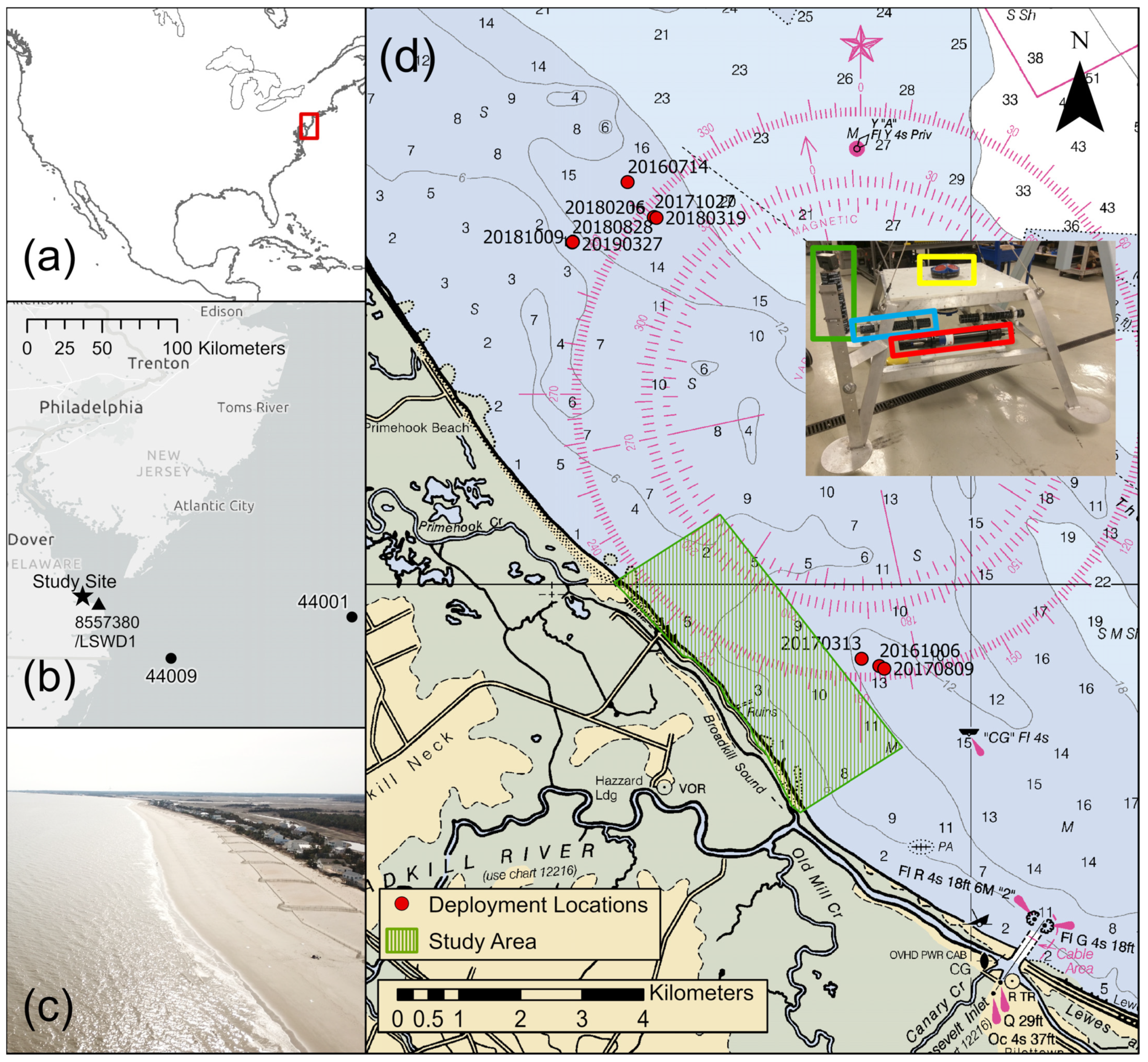
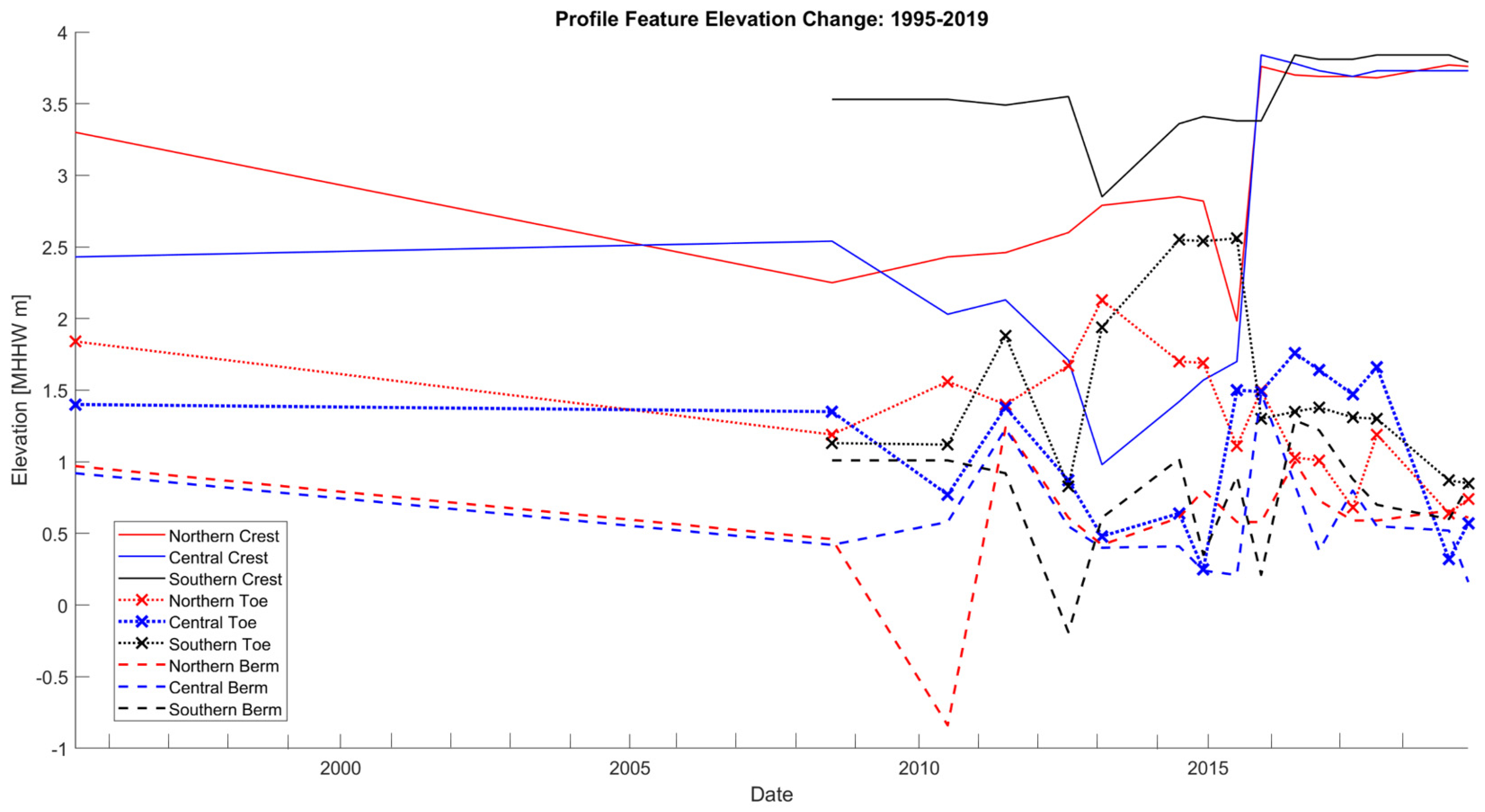




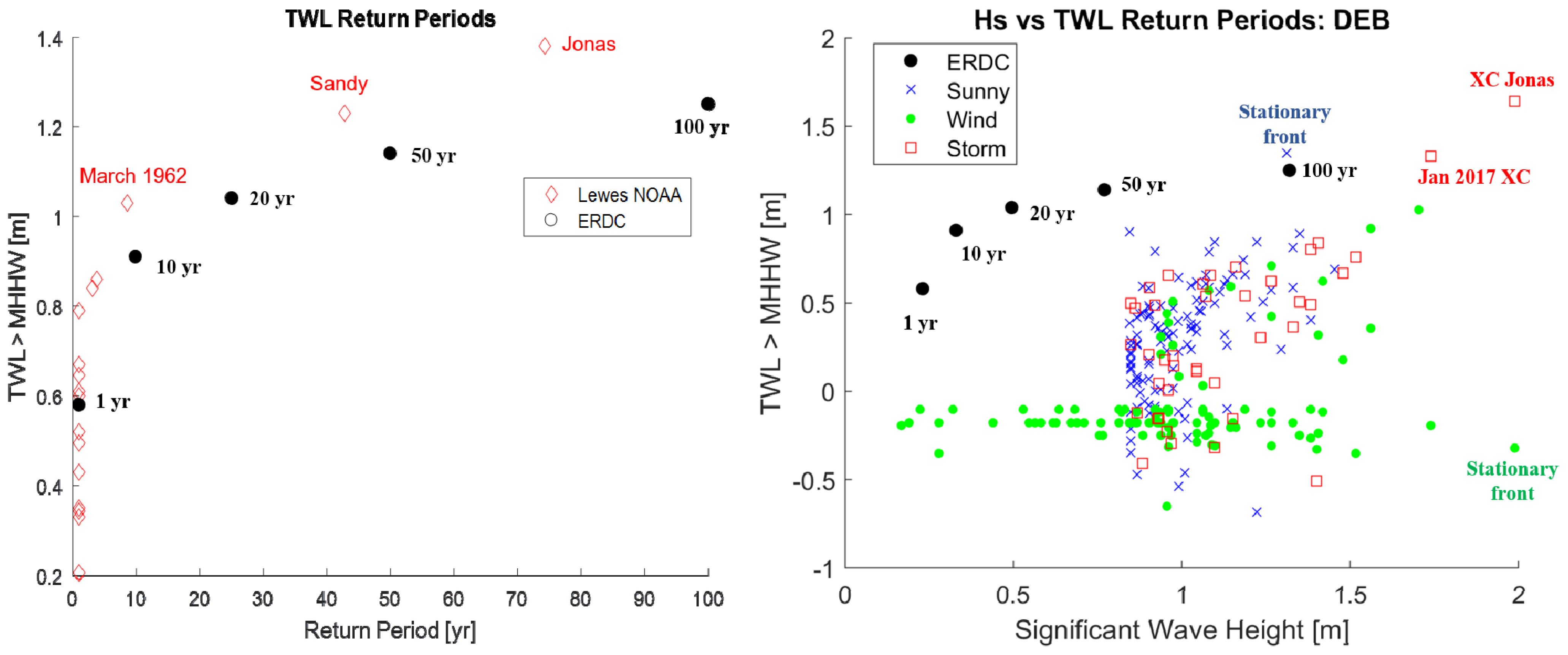

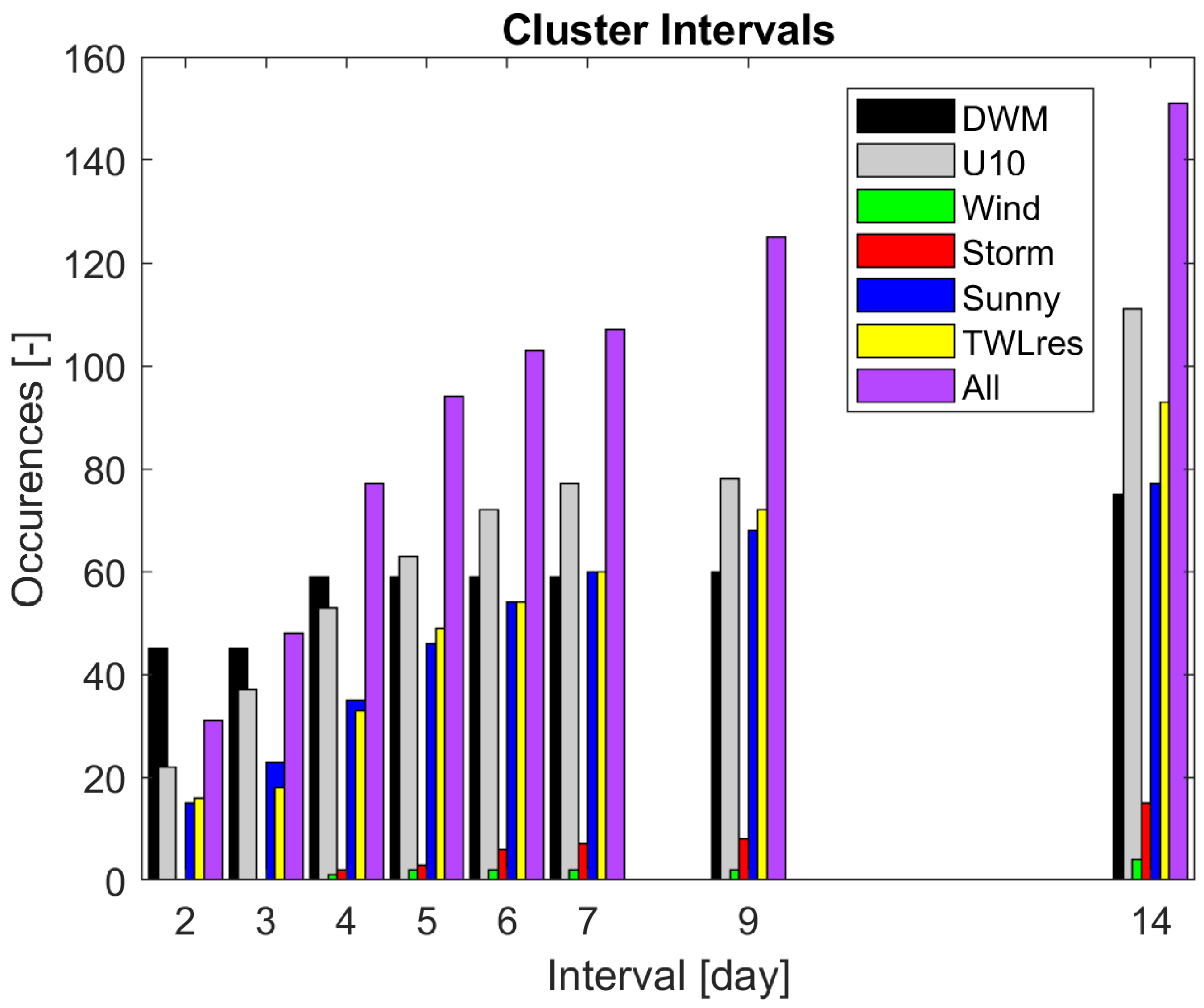
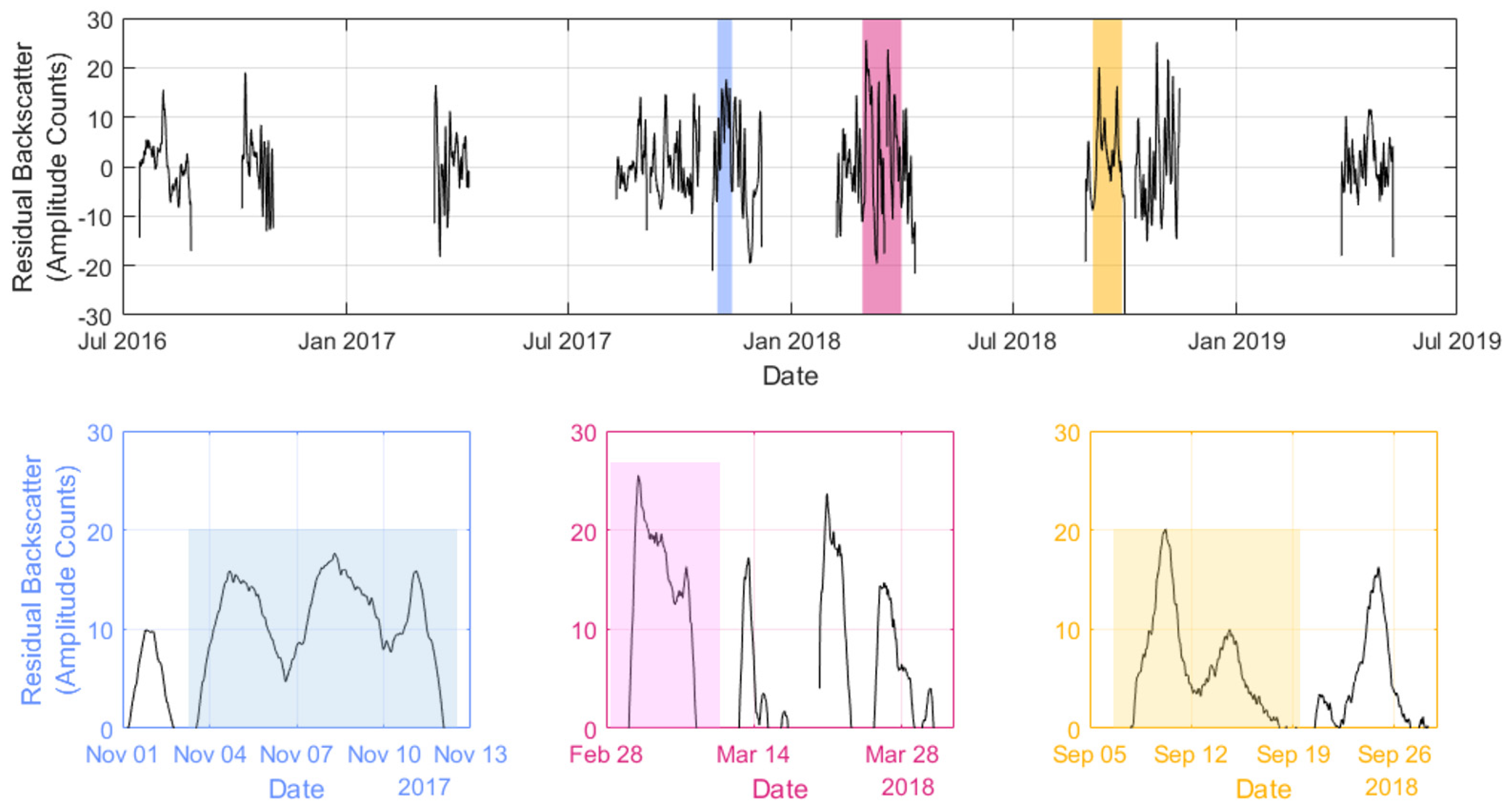
| hc | R2% | U10 Critical | d50 [mm] | τcr [Nm−2] | Θcr |
|---|---|---|---|---|---|
| 2.42 m | 0.63 m | 7.75 m/s | 0.48 ± 0.20 | 0.26 ± 0.06 | 0.038 ± 0.012 |
| Hs | U10 | TWLres | Dune Toe (MHHW) |
|---|---|---|---|
| 0.84 m | 13.64 m/s | 0.40 m | 1.0 m |
Publisher’s Note: MDPI stays neutral with regard to jurisdictional claims in published maps and institutional affiliations. |
© 2022 by the authors. Licensee MDPI, Basel, Switzerland. This article is an open access article distributed under the terms and conditions of the Creative Commons Attribution (CC BY) license (https://creativecommons.org/licenses/by/4.0/).
Share and Cite
Dohner, S.M.; DuVal, C.B. Quantifying Estuarine Hydrometeorological Coastal Hazards Using a Combined Field Observation and Modeling Approach. J. Mar. Sci. Eng. 2022, 10, 335. https://doi.org/10.3390/jmse10030335
Dohner SM, DuVal CB. Quantifying Estuarine Hydrometeorological Coastal Hazards Using a Combined Field Observation and Modeling Approach. Journal of Marine Science and Engineering. 2022; 10(3):335. https://doi.org/10.3390/jmse10030335
Chicago/Turabian StyleDohner, Stephanie M., and Carter B. DuVal. 2022. "Quantifying Estuarine Hydrometeorological Coastal Hazards Using a Combined Field Observation and Modeling Approach" Journal of Marine Science and Engineering 10, no. 3: 335. https://doi.org/10.3390/jmse10030335
APA StyleDohner, S. M., & DuVal, C. B. (2022). Quantifying Estuarine Hydrometeorological Coastal Hazards Using a Combined Field Observation and Modeling Approach. Journal of Marine Science and Engineering, 10(3), 335. https://doi.org/10.3390/jmse10030335






